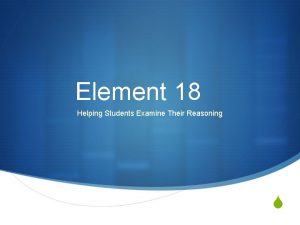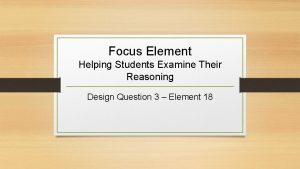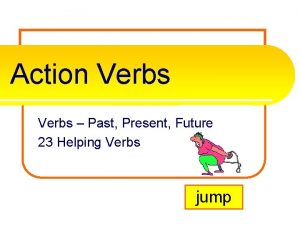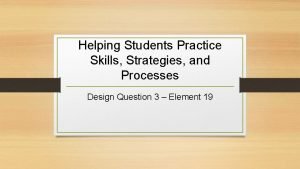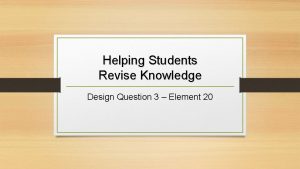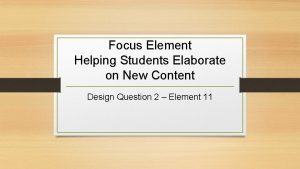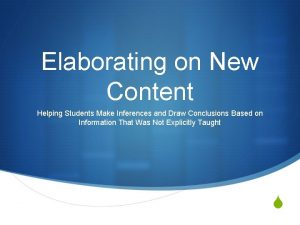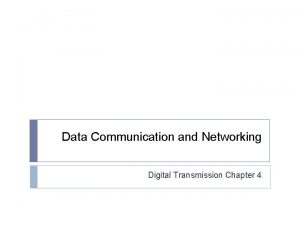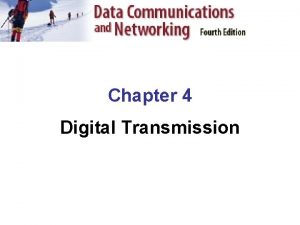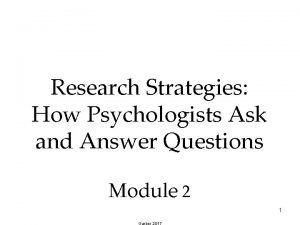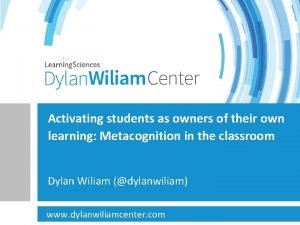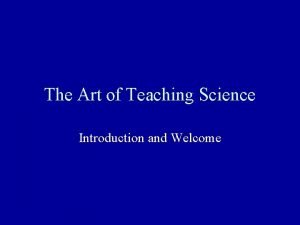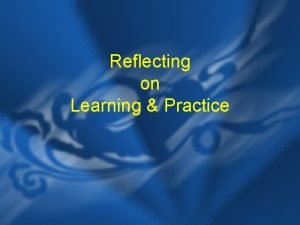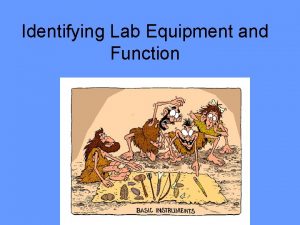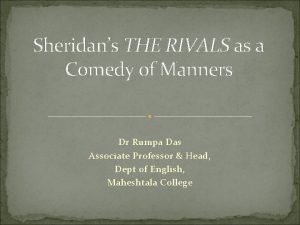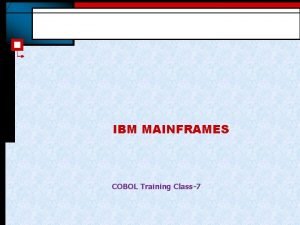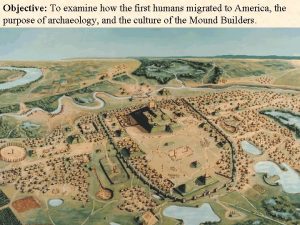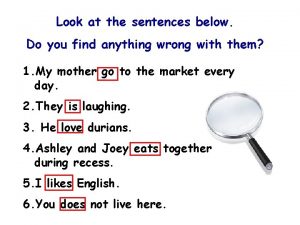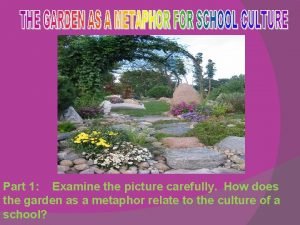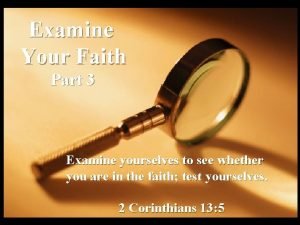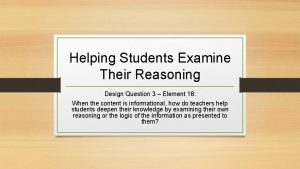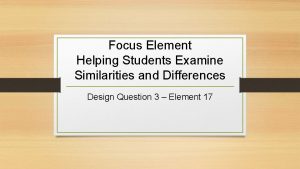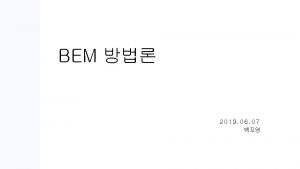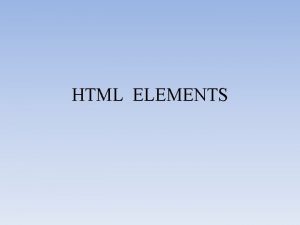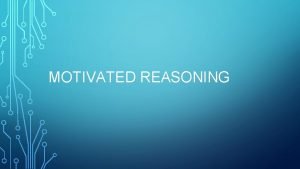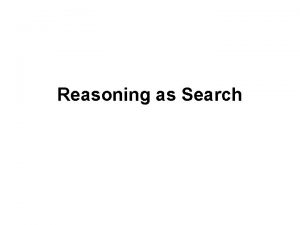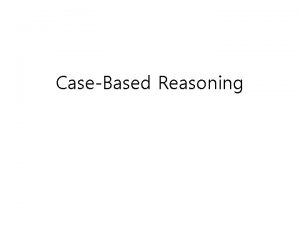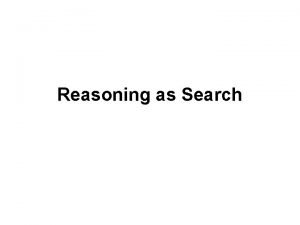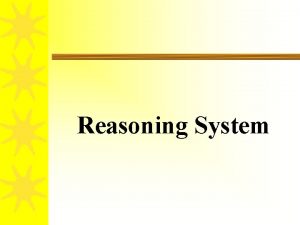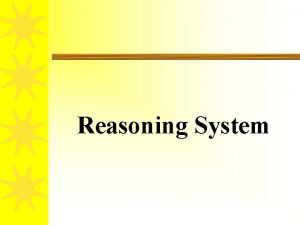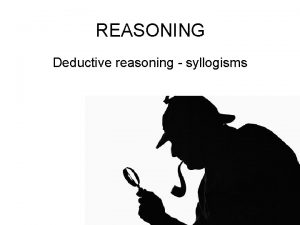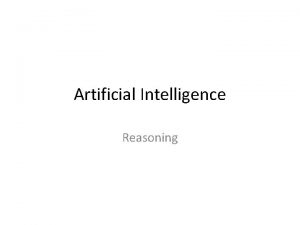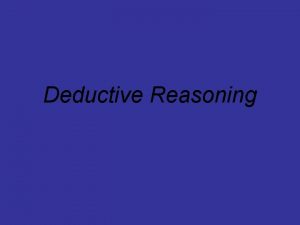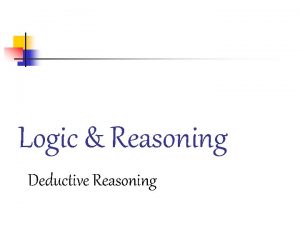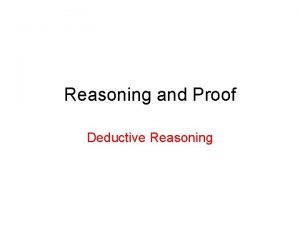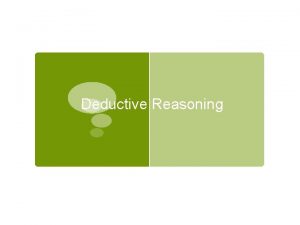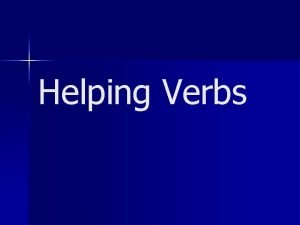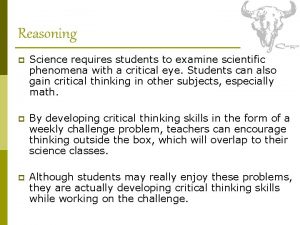Element 18 Helping Students Examine Their Reasoning S































- Slides: 31

Element 18 Helping Students Examine Their Reasoning S

Examining Reasoning S Helping students produce and defend claims S Claims that come from their own reasoning S Examining claims that are produced by other authors

Why This Element S Many of our standards demand that we incorporate this line of thinking into our learning experiences. S It’s a life skill that even we as adults can struggle with. S We need to improve our skill set to assist our students in developing this skill. S Only 2% of observed instructional experiences included reasoning. (Marzano and Toth 2014)

Teacher Behaviors for Effective Implementation S Identify the critical content to be examined S Directly model (think aloud), teach and facilitate the process for the students S Provide ongoing opportunities for students to examine their line of reasoning and that of others S Provide ongoing opportunities for students to support and defend claims in relation to evidence

Interconnectedness of the Elements 1. Identify Critical Content 2. Chunk it out 3. Preview the content 4. Allow time for students to process, elaborate, record and reflect on the content 5. Skillfully blend these elements together to achieve the goal of students deepening their learning in the content

Time, Time S This cannot be rushed S It takes time for students to wrestle with the information and think deeply about it. S Analyzing a line of thinking is a difficult, time intensive task. S In advance, think about the probing questions you can ask students to prompt their thinking. S Don’t rescue them because it’s taking too long in your mind. This productive struggle is where the learning takes place.

Monitor for Desired Effect S Students can: S Describe errors in information S Evaluate the efficiency of a S S process Explain the overall structure of the argument Identify and take various perspectives Identify support for perspectives with support Demonstrate this through the artifacts/work product

Monitor and Reflect S The more teachers monitor their students The difference and reflectaon how between good they are progressing teacher and a great in the learning teacher is the process, the better relentless equippedinspection they will be ofadjust student work. to their -Rick Du. Four instruction to meet student needs.


This should be ou r focus… We tend to monitor for compliance and engagement.

S What are the critical parts of this definition? S Teacher act S Checking evidence S Desired student learning of critical content S During instruction

Facilitation Grid for Monitoring Take your learning targets or criteria for success and put them on the facilitation grid. S Use some sort of collection tool as you monitor student progress toward the understanding of critical content. S A facilitation grid is one method. S Write the student names down the left side. S Write the learning targets or criteria you are looking for as you monitor student learning across the top. S In this case it is what ever you expect to see the students writing, doing or saying as you walk around. S As you walk around and monitor student work, check off who has it and who does not.

This is where we want to live. This is where we tend to spend most of our time currently.



Monitoring During Instruction S Teacher Observation: S Walk and listen to student conversations around critical content S Watch and listen to demonstrations, oral presentations, etc. of S S S critical content Spot check student work to determine progress Ask probing questions to redirect or elevate thinking Review student class work Observe students as they work with manipulatives Observe students as they respond by pointing to correct answers or represent the correct answer through body movement

Scaffold/Support-Adaptations S Use pictures, graphics, and diagrams S Provide sentence stems S Develop guiding/probing questions S Tell stories to illustrate examples S Regroup students to provide additional support S Show work samples or point out exemplars S Review reasoning behind responses before asking students to respond S Provide a brief overview of critical content S Post anchor charts, helpful lists, diagrams or techniques

Extension Adaptations S Students answer questions that stretch them just beyond the standard to deepen and extend their thinking. S Students categorize important terms and make generalizations based on those categories. S Students identify how each chunk of information or each activity relates to the learning targets. S Students identify similarities and differences between learning targets, and groups’ conclusions or solution methods. S Students create their own graphic organizer to share with the class. S Students identify strategies and techniques that were particularly useful to their knowledge gain. S Students create picture, graphics, and diagrams of previously learned skills or procedures to share with the class.

Connecting PLC Work - Monitoring S You are the content experts, so use each other’s experience and knowledge during your PLC time to: S Prioritize and problem solve around the most critical content students must learn. S Determine what mastery of the target/standard(s) looks like. S Analyze data in order to share successful strategies and meet the needs of all students. S Brainstorm scaffold/supports could be used to support student learning. S brainstorm extensions that could be used in the learning moment to extend student learning.

Scaffold to Meet Needs S Change the level of the text with the same content S Break down the content into several smaller chunks S Give students organizers or think sheets to clarify and guide their thinking, one task/step at a time

Instructional Strategies S Using logic to examine a response S Examine errors and the accuracy of a response S Examining the efficiencies of multiple methods of problem solving S Producing and defending claims related to content S Identify and analyze claims of an author’s work S Judging reasoning and evidence in an author’s work

Examine Logic in Reasoning S Logic is a step by step progression in thinking based on some sort of evidence. S Most basic questions: S Does this answer make sense? S Is my conclusion logical? S What kind of evidence have to support do I this statement?

Considerations S Teach the vocabulary of argumentation and logic in terms appropriate for the grade level S Teach and model the four types of errors in logic (faulty logic, attack, weak reference, misinformation) appropriate for your grade level S See the handout/module for a breakdown of each with descriptions and examples

Cautions S Complexity of example is appropriate for grade/cognitive level S Provide enough time to work through the process S Let students analyze and think with prompting and support from you S Students should identify the error by name S Students should use evidence to support their answers

Let’s take a peek. . S Read over the example and non-example. (You can download it from the module. ) S What does the teacher intentionally do in the example to support students during this learning experience? S What didn’t the teacher do in the non-example?

Examining Errors in the Accuracy of the Response S Usually happens because students jump to conclusions because: S The content is too difficult S They lack the appropriate background knowledge S They are working toward English proficiency S They are lazy thinkers S These students tend to hijack a conversation and elaborate with their own experiences.

How to help… S Develop a set of questions that students can consult when they jump to a conclusion and produce a wrong answer S Provide them with a checklist of reasons why they may have made an error in reasoning. (see module/handout) S Use authentic examples from: everyday life, newspapers, TV shows, and internet sources. S Hold a month long contest for students who bring in examples of errors in reasoning with evidence in the form of a video clip, print copy of a news story, web link. S Require justification in all they do S Anticipate errors and model them in presentation of the content

Producing and Defending Claims Related to Content S Teaching this strategy will take time and effort on both your part as well as the students. S This time and effort will yield results in deeper learning of the content. S Specialized Terms to teach: content, claim, assertion, support, grounds, backing and qualifiers (see handout/module for definitions and examples of each)

Steps to Process Content 1. Select the content-related, standards-aligned text you plan to use. 2. Identify the text structure (the way the author has organized the text). 3. Select an organizer that is appropriate for the text structure you have selected and model for students how to complete the organizer on a small chunk of text. 4. Chunk the text into manageable units and have students identify the elements of the text structure chunk by chunk as they complete their organizers.

After Interaction with Text 1. Assist students with identifying a claim from their initial interactions with the content. 2. Help students define the initial support (the grounds for the claim) 3. Help students develop backing (additional support) for the claim. 4. Have students frame the qualifier (exceptions/counterarguments to the claim). 5. Use an organizer to provide a framework for students to record the information they identified in the reading. (see module/handout) Model and Think Aloud Each Step

Additional Resources S For additional information you can refer to the Essentials for Rigor Series-Processing New Information. Examining Reasoning
 Helping students examine their reasoning
Helping students examine their reasoning Helping students examine their reasoning
Helping students examine their reasoning Maybe mr do should have a will
Maybe mr do should have a will Learning targets helping students aim for understanding
Learning targets helping students aim for understanding Helping students practice skills, strategies, and processes
Helping students practice skills, strategies, and processes Helping students revise knowledge
Helping students revise knowledge Helping students elaborate on new content
Helping students elaborate on new content Helping students elaborate on new content
Helping students elaborate on new content An example of deductive reasoning is:
An example of deductive reasoning is: Inductive reasoning patterns
Inductive reasoning patterns Deductive vs inductive reasoning
Deductive vs inductive reasoning Inductive and deductive reasoning examples
Inductive and deductive reasoning examples Examples of deductive reasoning
Examples of deductive reasoning Definition of inductive method
Definition of inductive method Deductive method
Deductive method Rizal involved in student demonstration
Rizal involved in student demonstration Difference between data element and signal element
Difference between data element and signal element Signal element vs data element
Signal element vs data element A person displays a set of rare behaviors
A person displays a set of rare behaviors Activating students as owners of their own learning
Activating students as owners of their own learning Students reflection on their learning sample
Students reflection on their learning sample Teachers
Teachers Students reflection on their learning sample
Students reflection on their learning sample Neither of my two suitcases is adequate for this trip
Neither of my two suitcases is adequate for this trip Which laboratory tools can be used to magnify small objects
Which laboratory tools can be used to magnify small objects Linear depreciation function
Linear depreciation function Discuss sheridan's the rivals as a comedy of manners
Discuss sheridan's the rivals as a comedy of manners String syntax in cobol
String syntax in cobol Examine
Examine Look at the sentences below
Look at the sentences below Examine the picture carefully and answer the question
Examine the picture carefully and answer the question Examine your faith
Examine your faith
